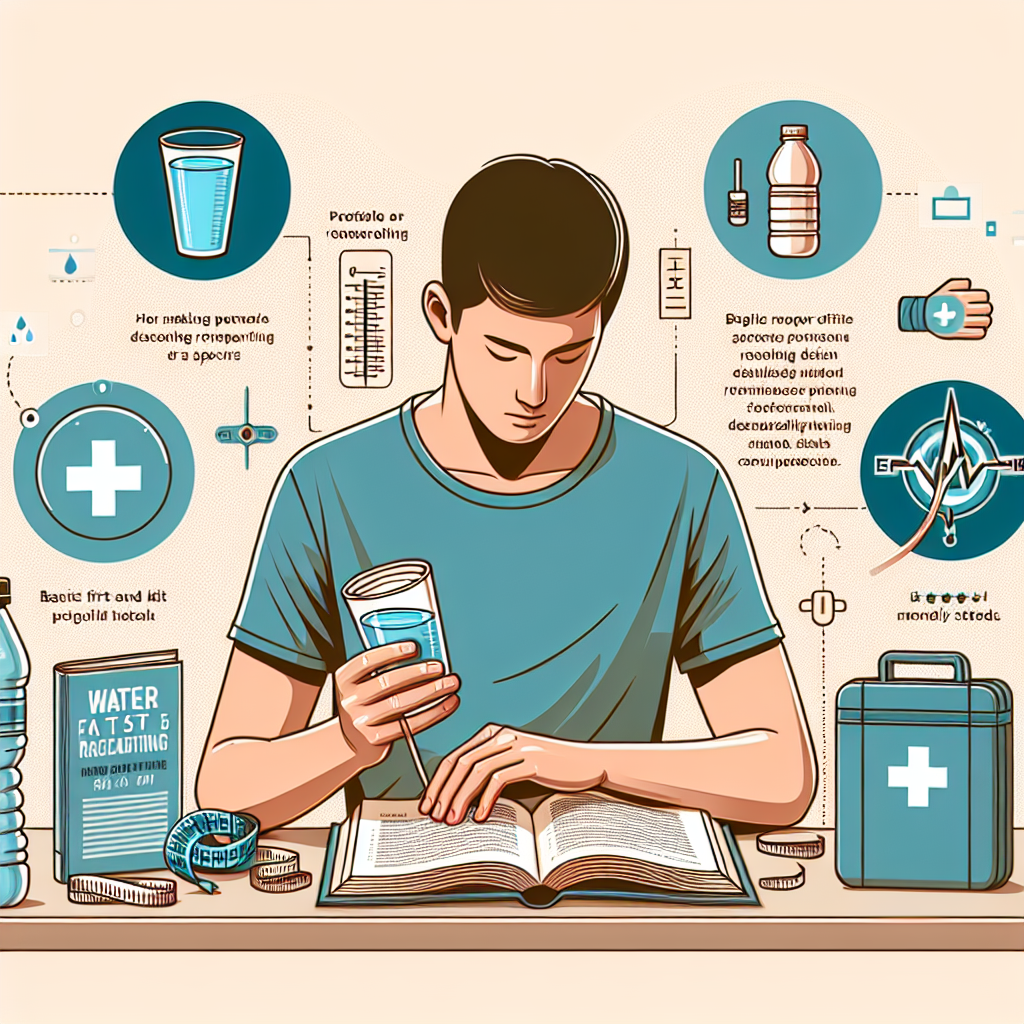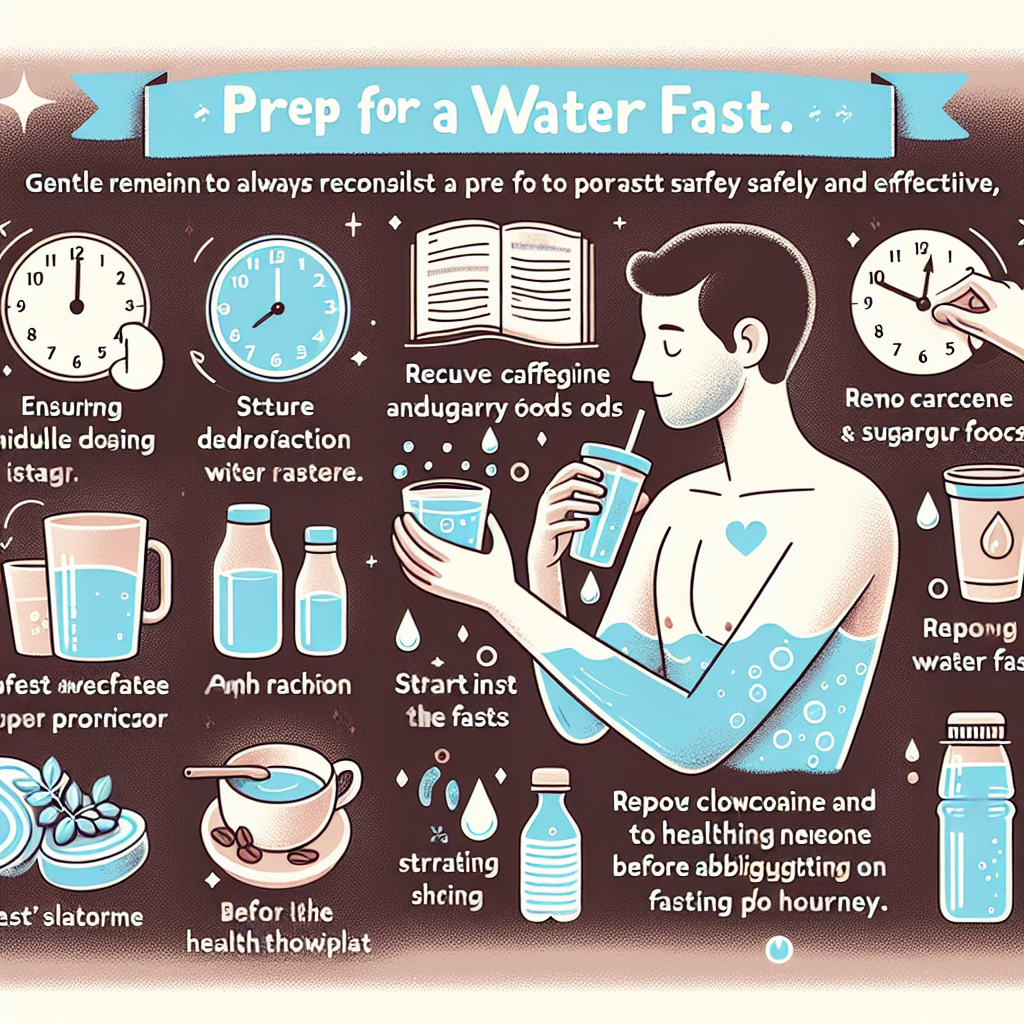How to Prep for a Water Fast Safely and Effectively

Ready to start a water fast safely and effectively? Learn the best preparation methods and tips at My Vibrant Vitality. Start your journey towards a healthier lifestyle today!
Essential Steps to Prepare for a Water Fast Safely
Embarking on a water fast can be a transformative experience, but it’s crucial to approach it with the right preparation to ensure safety and effectiveness. A water fast, which involves consuming only water for a set period, can offer potential health benefits such as weight loss, improved digestion, and enhanced focus. However, it’s not without risks, especially if not done correctly. Therefore, it’s essential to understand the steps to prepare for a water fast safely.
Firstly, it’s important to consult with a healthcare professional before starting a water fast. This is especially crucial for individuals with underlying health conditions, such as diabetes or heart disease, as fasting can exacerbate these conditions. A healthcare professional can provide personalized advice and monitor your health throughout the fast.
Once you’ve received medical clearance, the next step is to gradually reduce your intake of processed foods, caffeine, and alcohol in the weeks leading up to the fast. This helps to minimize withdrawal symptoms such as headaches and fatigue. Instead, focus on consuming nutrient-dense foods like fruits, vegetables, lean proteins, and whole grains to nourish your body and prepare it for the fast.
Hydration is another key aspect of preparation. In the days before the fast, ensure you’re drinking plenty of water to keep your body well-hydrated. This will help to prevent dehydration during the fast. It’s also beneficial to add electrolytes to your water to maintain a balance of minerals in your body.
Mental preparation is just as important as physical preparation. Fasting can be a challenging experience, both physically and emotionally. Therefore, it’s essential to prepare yourself mentally for the journey ahead. This could involve setting clear intentions for the fast, practicing mindfulness, or engaging in stress-reducing activities such as yoga or meditation.
Another crucial step is to plan your schedule during the fast. It’s advisable to start your fast when you have a few days off work or other commitments, as you may experience fatigue or other side effects. It’s also important to plan for adequate rest during the fast, as your body will be using its energy to heal and detoxify.
Lastly, it’s important to have a plan for breaking the fast. This should involve gradually reintroducing foods into your diet, starting with easily digestible foods like broths or smoothies. This helps to prevent digestive issues and allows your body to adjust back to a normal diet.
In conclusion, preparing for a water fast involves a combination of medical consultation, dietary adjustments, hydration, mental preparation, scheduling, and planning for breaking the fast. By following these steps, you can ensure that your water fast is safe and effective. Remember, a water fast is not a quick fix, but a journey towards better health. Therefore, it’s essential to approach it with care, patience, and respect for your body’s needs.
Effective Techniques for a Safe and Successful Water Fast

Water fasting, a period when you consume only water, is a type of fast that has been practiced for centuries as a spiritual or therapeutic practice. Today, it is also recognized for its potential health benefits, including weight loss, improved focus, and detoxification. However, it’s crucial to approach water fasting with caution and preparation to ensure it’s done safely and effectively.
Before embarking on a water fast, it’s essential to consult with a healthcare professional. This is particularly important for individuals with underlying health conditions, such as diabetes or heart disease, as fasting can pose significant health risks. A healthcare professional can provide personalized advice and monitor your health throughout the fast.
Once you’ve received medical clearance, the next step is to prepare your body for the fast. This involves gradually reducing your intake of processed foods, caffeine, and alcohol in the weeks leading up to the fast. Instead, focus on consuming nutrient-dense foods like fruits, vegetables, lean proteins, and whole grains. This not only helps to nourish your body but also reduces potential withdrawal symptoms during the fast.
Hydration is another critical aspect of preparation. In the days leading up to the fast, ensure you’re drinking plenty of water to keep your body well-hydrated. This will help to prevent dehydration during the fast, which can lead to headaches, fatigue, and dizziness.
Mental preparation is just as important as physical preparation. Water fasting can be a challenging experience, both physically and emotionally. It’s essential to enter the fast with a positive mindset and realistic expectations. Consider practicing mindfulness or meditation techniques to help manage potential stress or discomfort during the fast.
During the fast, it’s crucial to listen to your body and rest as needed. While some people may experience increased energy levels during a fast, others may feel more fatigued. It’s important to adjust your activity levels accordingly and avoid strenuous exercise.
Monitoring your health throughout the fast is also vital. Regularly check your blood pressure and blood sugar levels, and be aware of any signs of distress, such as severe dizziness, heart palpitations, or fainting. If you experience any of these symptoms, it’s important to end the fast and seek medical attention immediately.
Finally, breaking the fast correctly is just as important as the fast itself. It’s recommended to gradually reintroduce food to your system, starting with small amounts of easily digestible foods like fruits or broth. This helps to prevent digestive discomfort and allows your body to adjust back to regular eating patterns.
In conclusion, water fasting can offer numerous potential health benefits, but it’s crucial to approach it with caution and preparation. By consulting with a healthcare professional, preparing your body and mind, monitoring your health, and breaking the fast correctly, you can ensure a safe and successful water fast. Remember, everyone’s experience with fasting is unique, and what works for one person may not work for another. Therefore, it’s important to listen to your body and adjust your approach as needed.
Mastering the Art of Water Fasting: Preparation Tips and Guidelines
Water fasting, a practice that has been around for centuries, is gaining renewed attention in the health and wellness community. This practice involves abstaining from all food and drink, except water, for a specific period. While it may seem daunting, with the right preparation, you can embark on a water fast safely and effectively.
Before you begin, it’s crucial to understand the purpose of your fast. Are you doing it for weight loss, detoxification, or spiritual reasons? Knowing your motivation will help you stay committed during the challenging moments. It’s also essential to consult with a healthcare professional before starting a water fast, especially if you have any underlying health conditions. They can provide guidance and monitor your progress throughout the fast.
Once you’ve received the green light from your healthcare provider, start preparing your body for the fast. Gradually reduce your intake of processed foods, caffeine, and alcohol in the weeks leading up to your fast. This step will help minimize withdrawal symptoms such as headaches and fatigue. Instead, focus on consuming nutrient-dense foods like fruits, vegetables, lean proteins, and whole grains to nourish your body.
Hydration is key during a water fast. Ensure you’re drinking enough water before, during, and after your fast. The amount of water you need can vary based on factors like your weight, activity level, and climate. However, a general guideline is to aim for at least eight 8-ounce glasses of water per day.
While water fasting, it’s important to listen to your body and rest as needed. You may experience lower energy levels, especially in the beginning. Light activities such as walking or yoga can be beneficial, but avoid strenuous exercise.
Mental preparation is just as important as physical preparation. Water fasting can be a challenging experience, both physically and emotionally. It’s normal to feel a range of emotions, from excitement to fear. To help manage these feelings, consider incorporating mindfulness practices such as meditation or journaling into your routine. These can help you stay present and focused during your fast.
During your fast, monitor your health closely. If you experience severe symptoms such as dizziness, confusion, or rapid heart rate, it’s important to seek medical attention immediately. Remember, the goal of a water fast is not to push your body to its limits, but to give it a chance to rest and reset.
After your fast, reintroduce food slowly and carefully. Start with small amounts of easily digestible foods like fruits or cooked vegetables. Gradually increase the quantity and variety of foods over several days. This step is crucial to prevent refeeding syndrome, a potentially serious condition that can occur when food is reintroduced too quickly after a fast.
In conclusion, water fasting is a powerful tool that can offer numerous health benefits when done correctly. However, it’s not a quick fix or a one-size-fits-all solution. It requires careful preparation and should be done under the guidance of a healthcare professional. By following these guidelines, you can embark on a water fast safely and effectively, reaping the maximum benefits while minimizing potential risks.